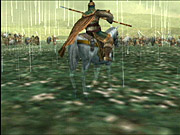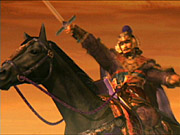The Three Kingdoms period was the very height of chivalry and warfare for ancient China. By continually tapping into this rich historical background, developer and publisher Koei may be entering a golden age as well. While the long-running Romance of the Three Kingdoms strategy series has yet to gain much fame outside of Asia, the action-oriented Dynasty Warriors titles have done well with Western audiences. In Dynasty Tactics, Koei uses the same historical backdrop to focus on battlefield tactics, while retaining the drama and excellent presentation that have made its recent efforts so successful. The resulting game is more accessible than the Romance series, though still best suited to strategy gamers looking for a serious way to spend their playtime.

Before you choose to play as one of three legendary figures whose goal is to unify all of China, the game will put you through a three-part tutorial that teaches you the basics of battle and introduces you to a number of key concepts. Once you've completed several exercises, you'll see an introductory cinematic and be thrust into the heat of battle. A help window will appear the first time you encounter a particular aspect of the game, giving a detailed explanation and an immediate chance to put your new knowledge to use. This keeps the basic learning curve manageable and helps to balance the depth of the game's underlying systems.
Dynasty Tactics centers on skilled generals who command thousands of soldiers as single units. Several units together compose an army. The battlefield is divided into a grid, where squares of varying terrain make up the playing field. A unit's morale is determined by the general's leadership ability and various other factors. In turn, morale dictates the order in which units take action. While the relative sizes as well as strengths and weaknesses of each unit must be considered, the "tactics" themselves are the crux of gameplay. These are actual techniques available to each general, and mastering when and in what combinations to use them is the key.
Each general has his own list of formidable tactics at his disposal, displayed in a queue on the unit's status screen. The effects of these commands can be used for raising and lowering morale, changing unit positions on the battlefield, attacking multiple units at once, and more. Whether you use them wisely or squander them foolishly will ultimately decide the outcome of the battle. Each of the many tactics has its own unique requirements and effects. For instance, to use the "flank" maneuver you need to be adjacent to and facing the side of an enemy unit. When executed, the enemy will be pushed forward one space in the direction they were facing and lose morale.
While tactics are powerful when used alone, they're devastating when combined. If the usage of one command creates the condition for another, that tactic will be triggered, and a "tactical combo" will result. The damage enemies will sustain will increase as each maneuver is performed in succession, but it does take a certain degree of planning. A tactic must be at the top of a general's queue to be triggered and must relate to either the unit that just acted or the units that were targeted by the previous action. "Tactical links" can also be used by strategists, which are triggered only when another specialized technique is used anywhere on the map. The catches are that the linked units cannot be a direct target for another tactic, and poorly planned links are easily broken.
Orchestrating a successful combo can eliminate thousands, even tens of thousands, of enemies from the battlefield and create deeply satisfying moments for the player. Each coordinated assault is depicted by a very capable graphics engine, showing the specific unit types, terrain, and actions. When certain conditions are fulfilled you may even see your generals perform godlike feats on the battlefield, effortlessly striking down enemy soldiers with amazing power and grace. If you manage to defeat an enemy with a large combo, you might actually capture and add him to your stable of officers.
More and more depth will reveal itself from this inventive tactics system over time. As you become able to think farther ahead and learn the finer points of tactical combination, you'll begin to develop a keen awareness of turn order and formulate your own strategies. When you can intelligently order a general's tactics on the list, you'll truly be playing the game on a high level, and you'll probably find yourself really enjoying the game.

You'll also be charged with organizing and commanding your armies on a broad scale. Generals will grow stronger as they gain experience, learning new tactics and learning to command more-advanced troop types. The type and order of a commander's equipped tactics can be adjusted, and equipping special items will further improve his abilities.
The soldiers themselves are divided into four main classes: infantry, archers, cavalry, and special. More experience is required to command the advanced troops, but no troop type will become totally obsolete. The lowly footmen have the worst attack and defense ratings in their class, but their large shields make them highly resistant to arrows. Cavalry have superior strength and speed and are strong against most ground units, but they fight poorly in forests and are weak against spears and pikes.
When your armies are composed to your liking, you'll directly control their movement on a large map during the strategy phase. You can also send a spy to gather information on a prospective battlefield or send a diplomat to negotiate a treaty or alliance. There's no resource management, and you're given a lot of flexibility to reorganize units and change orders before ending your turn and putting your orders into action. It's simple, but it adds a lot to the experience.

Though you are given an extra layer of control, there are few shortcuts when organizing your armies, and you'll need to do a good bit of sorting and exercising your memory at times. Units that can't reach their destination in one turn must be manually commanded again the next turn if you don't want them to sit and gather dust. It's also frustrating that you must select an envoy or army directly from the map before giving them movement commands. Make no mistake, the true meat of the game is the tactical combat, but the strategy mode does serve pretty well on the side.
Each of the game's campaigns is divided into scenarios with specific goals, but the choices you make will influence the way history progresses. All three main scenarios are branching paths with story scenes and CG movies liberally interspersed. The amount of divergence is impressive and can lead to drastically different events and outcomes. To see them all would require you to play through as each general several times and would require hundreds of hours of gameplay. Furthermore, a two-player mode lets you compete against a friend in random battles exactly as you would in the campaign, and finishing the game once will unlock a history function where you can view the path you took through the story (as well as replay any scenes you wish) and check the statistics of your most damaging tactical combos.
The graphical and visual aspects of the game are more than competent. Character models for the 225 generals are quite detailed, with many featuring completely customized appearances from their face to their battle dress and weapon of choice. The 17 types of soldiers appear in droves, and they look and animate well as they fight for the honor and glory of their lords.
Brief but exciting action sequences highlight important events on the battlefield without causing any noticeable delay or load time. The cinematography on and off the battlefield is admirable, with dramatic camera direction lending a sense of style to an already solid presentation. If there are any visual faults, they can be found in the sometimes-repetitive maps. While the battle sequences remain entertaining because of the variety of actions, terrain, weather conditions, and soldier types, the static battlefield maps are devoid of unique features and differ only in their layout.
The soundtrack is skillfully composed of traditional music, featuring none of the electric guitar bravado found in Dynasty Warriors. Music during battle is nondescript but dynamic, playing softly and slowly at the beginning of battle and swelling up during critical moments. That the actual number of battlefield compositions is limited to only a few pieces is a bit disappointing. Voices for characters are all in English, and for the most part they at least live up to the standard for video game voice acting, despite a few embarrassing performances. The sounds of war are very well done. The splash of rain and mud under the feet of an army doesn't affect combat but is rather impressive to hear.

Even with its few drawbacks, the game has a lot to offer fans of strategy games or of the Three Kingdoms period. The translation is very well done on all accounts, and biographies (composed of data from historical sources and popular fiction) are included for each general. It is possible that those who aren't familiar with the setting or culture may feel overwhelmed by all the foreign names, but you'll quickly learn to identify and appreciate your most valuable generals as they distinguish themselves on the battlefield.
A bit more work on the broad-scale strategy portions and the interface could have made Dynasty Tactics virtually above reproach. As it is, though, the rich setting, wealth of options, and gratifying gameplay still make Dynasty Tactics a great purchase for strategy enthusiasts.